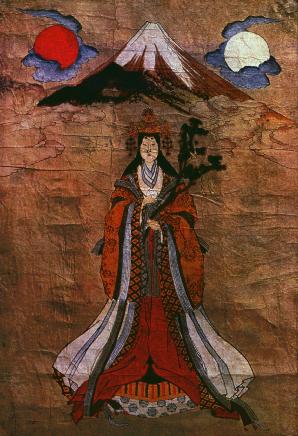

Geography/Culture: Ainu. Hokkaido, Japan, and the still further north islands in what was the Soviet Union.
Linguistic note: Fuji is almost certainly a word of Ainu origin. Apparently the name of the mountain is variously reinterpreted in Japanese to mean `the mountain of wealth', `Peerless', and `Unmatched'. It is not clear whether these meanings refer to the form Fujiyama, the name of Her mountain. One might suppose the element -yama is Japanese for mountain. If however it is the same word as Hindustani yama, as implied by Walker, then it is `death' in the masculine form.
Description: Holy Mother-mountain; She Who joins heaven to the underworld; perhaps Goddess of volcanic fire; Eponym of the sacred, extinct volcano, Fujiyama; Guardian of the nation; Goal of pilgrims; Ancestress and Protectress; Ever present Old Goddess of the central hearthfire; Guardian of the house; She Who invisibly welcomes the bearcub-spirit guest and talks with him all night. It is not clear whether the mountain was named Fuji, as the habitation of, or as their Ancestress Herself, by the Ainus when they lived in Honshu (the main island), or whether it was named by the invaders after the fire Goddess Whom they knew to be the Deity of those they had ousted.
To Whom are sacred: black bearcub; inao, `message bearers' (prayer-sticks two to five feet long whittled to leave a clump, like a head, of shavings at the top); ok-numba-ni `the poles for strangling' (two long thick poles used to strangle the bearcub at the iyomande sacrifice); fire; Fujiyama (the last volcanic eruption was in 1707); the month of July (when thousands of pilgrims, after ritual purification, climb to Her summit).
Festival: the iyomande, `to send away'. In September (when the time is judged right) a bear-cub (raised for the purpose) is sacrificed and sent to the bear Divinities with messages from humanity of reverence and pleas for continuance of bounty.
Male associates: consort (husband of the fire), Chisei-Koro-Inan, `ancestral-caretaker-of-the-house'consort (husband of the fire), Chisei-Koro-Inan, `ancestral-caretaker-of-the-house', in form a special prayer-stick with a small gash at the top representing a mouth, kept in the sacred northeast corner of the house.
Titles, Variants, etc.
Sources: Campbell PM 336-39; Monaghan BGH 112-3; Piggott JM 11; Walker WEMS 326, 381, 696.
Geography/Culture: Shinto. South Kyushu, Japan.
Linguisitic note: in India, naga (the female form is nagi), is a general term for both `snake' and `elephant' (perhaps refering to its snakelike trunk), or the devotee of a snake-cult. Snakes are said to be the guardians of the mineral wealth of the earth which is itself especially associated with mountains.
Description: Ugly, perhaps snakelike, Goddess of mountains, and Guardian of their mineral wealth; Princess of rocks; She Whose progeny, though snow fall and winds blow, will live eternally, indestructable as the enduring rocks; Pronouncer of curses.
To whom are sacred: {snakes}; rocks.
Male associate: Father, O-Yama-Tsu-mi, (Oho-Yama), god of the mountains, the Great Mountain Possessor.
Titles, Variants, etc.
Sources: Campbell MGOR 473-4; Couchoud AMDDEM 396; BGH 168; Larousse NLEM 416; Piggott JM 22; Stutley HDH 198.
Geography/Culture: Shinto. South Kyushu, Japan. A grove of cherry trees surrounds Her shrine.
See Linguistic note at Tatsuta-Hime.Description: Maiden Goddess of spring and blossoming fruit trees; She Whose progeny are beautiful but brief of life, to bloom and fade and fall like blossoms of the spring; She Who is associated with fire.
To Whom are sacred: cherry-trees and their blossom; a house without doors (in which She enclosed Herself when about to give birth); fire (She set fire to the doorless house when Her triplets (or some say twins) were born, but they were all preserved - this may a reference to the new growth which springs up after forest fires).
Male associates: Consort, Ninigi, `Prince-ruddy-rice-ear-plenty'. Sons, Hikohohodemi (Hohodemi), a huntsman; Hosuseri, a fisherman; Hoderi, (some say he is the fisherman). (Their children included `Fire-flash', and `Fire-fade', perhaps translations of two of the above names).
Titles, Variants, etc.
Sources: Couchoud AMDDEM 396; Campbell MGOR 473-4; Carlyon GG 103, 107, 110; Larousse NLEM 412; Monaghan BGH 167-8; Piggott JM 22.
Geography/Culture: Shinto. Honshu, Japan. Her shrine is built on the peak of Mount Fujiyama.
Description: Goddess of Mount Fujiyama; She to Whose peak pilgrims climb to worship the rising sun.
Male associates: Mount Fuji is the abode of the supreme deity Kunitokotachi.
Titles, Variants, etc.
Source: Carlyon GG 110; Cotterell DWM 102; Couchoud AMDDEM 407; Monaghan BGH 267, 168; Larousse NLEM image 408, 416.